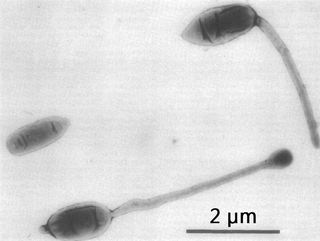
Thermus is a genus of thermophilic bacteria. It is one of several bacteria belonging to the Deinococcota phylum. Thermus species can be distinguished from other genera in the family Thermaceae as well as all other bacteria by the presence of eight conserved signature indels (CSIs) found in proteins such as adenylate kinase and replicative DNA helicase as well as 14 conserved signature proteins (CSPs) that are exclusively shared by members of this genus.

The Hyphomicrobiaceae are a family of bacteria. Among others, they include Rhodomicrobium, a genus of purple bacteria.
Alteromonas is a genus of Pseudomonadota found in sea water, either in the open ocean or in the coast. It is Gram-negative. Its cells are curved rods with a single polar flagellum.
Jeotgalicoccus is a genus of Gram-positive, facultatively anaerobic, and halotolerant to halophilic bacteria. The cells are coccoid. The genus is named after the Korean fish sauce jeotgal, whence these bacteria were first isolated.
Actinoalloteichus is a genus in the phylum Actinomycetota (Bacteria).
Agromyces is a genus in the phylum Actinomycetota (Bacteria).
Algoriphagus is a genus in the phylum Bacteroidota (Bacteria).
Virgibacillus is a genus of Gram-positive, rod-shaped (bacillus) bacteria and a member of the phylum Bacillota. Virgibacillus species can be obligate aerobes, or facultative anaerobes and catalase enzyme positive. Under stressful environmental conditions, the bacteria can produce oval or ellipsoidal endospores in terminal, or sometimes subterminal, swollen sporangia. The genus was recently reclassified from the genus Bacillus in 1998 following an analysis of the species V. pantothenticus. Subsequently, a number of new species have been discovered or reclassified as Virgibacillus species.
Maritalea is a genus of Gram-negative, strictly aerobic, oxidase- and catalase-positive, rod-shaped, motile bacteria with peritrichous flagella from the family of Hyphomicrobiaceae.
The class Holophagaceae is a family of strictly anaerobic Gram negative marine bacteria in the phylum Acidobacteriota.
Streptomyces abyssalis is a bacterium species from the genus Streptomyces which has been isolated from deep sea sediments in the South China Sea on the Xisha Islands in China.
Streptomyces glycovorans is a bacterium species from the genus of Streptomyces which has been isolated from marine sediments of the South China Sea near the Xisha Islands in China.
Streptomyces xishensis is a bacterium species from the genus of Streptomyces which has been isolated from marine sediments from the South China Sea near the Xisha Islands in China.
Alkalibacterium is a genus in the phylum Bacillota (Bacteria).
Lewinella is a Gram-negative, chemoorganotrophic and aerobic genus from the family Lewinellaceae.
Neptunomonas is an anaerobic and rod-shaped genus from the family of Oceanospirillaceae.
Thalassotalea is an aerobic and chemo-organo-heterotrophic genus of bacteria from the family Colwelliaceae which occur in the ocean and in sea ice.
Acanthopleuribacter pedis is a Gram-negative, rod-shaped bacterium found in marine environments.
Virgibacillus kapii is a Gram-positive and rod-shaped bacterium from the genus of Virgibacillus which has been isolated from Thai shrimp paste from Nakhon Si Thammarat Province in Thailand.
Alkalibacterium gilvum is a Gram-positive, non-spore-forming, halophilic, alkaliphilic and non-motile bacterium from the genus Alkalibacterium which has been isolated from cheeses from Europe.

